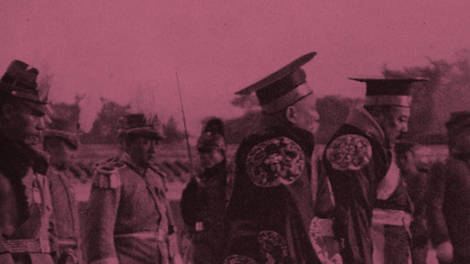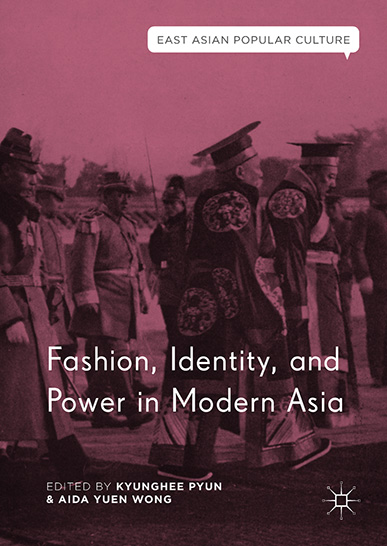
Fashion, Identity, and Power in Modern Asia (2018), Kyunghee Pyun and Aida Yuen Wong, editors

From the time that Japanese satirist Kanagaki Robun mocked “half civilized” and self-important men for wearing hybrid sartorial disasters in his 1871 short story, “The Beefeater,”1 East Asian political leaders, cultural trendsetters, and advocates and opponents of modernization have been keenly aware of the power of fashion to “assert allegiances, influence behaviors, and reshape society.”2 The editors of this fine collection have brought together fourteen essays that span China, Japan, and Korea in the late nineteenth and early twentieth centuries; Korea, Taiwan, and Hong Kong under colonialism; and trade in Western fabrics (woolens) in the early modern period in Japan (Tokugawa period) and China (Qing dynasty). All the chapters in this book, in varying ways, treat the intersection of Western clothing, accessories, hair fashions, and fabrics with existing local versions of those aspects of dress and representation of the body.
 The editors group the essays in the collection into four categories: garments and uniforms, accessories, fabrics, and fashion styles. Several themes transcend those categories. The most frequently addressed theme is what I would call “invented tradition.” Tradition has several important characteristics. First, tradition is in the eye of the beholder. One person’s articulation of tradition may have little to do with another’s. People in positions of power often define tradition in ways that allow them to retain power. Second, the use of tradition is often gendered. As historian Sharon Sievers noted over thirty years ago, women in rapidly changing Meiji Japan were set up as “repositories of tradition” in law, society, and dress.3 Modernity was the province of men, and women’s assignment as the preservers of tradition in Meiji Japan was a way to smooth the rough edges of change that often felt too rapid. Another common theme in these chapters is that of class. Several chapters address clothing to be worn in specific classed situations, such as at the monarch’s court or in carrying out professional duties, including those associated with diplomacy or interaction with foreigners in government or in international religious meetings. Other themes that appear in several chapters include: hybridity in clothing and accessory styles—these hybrid styles were often not chosen by chance but were intended to make a political point; the role of empire and power in the wearing of Western-style uniforms; and the long-standing importance of imports of Western woolen fabrics, which are usually absent from historical studies of trade and commerce.
The editors group the essays in the collection into four categories: garments and uniforms, accessories, fabrics, and fashion styles. Several themes transcend those categories. The most frequently addressed theme is what I would call “invented tradition.” Tradition has several important characteristics. First, tradition is in the eye of the beholder. One person’s articulation of tradition may have little to do with another’s. People in positions of power often define tradition in ways that allow them to retain power. Second, the use of tradition is often gendered. As historian Sharon Sievers noted over thirty years ago, women in rapidly changing Meiji Japan were set up as “repositories of tradition” in law, society, and dress.3 Modernity was the province of men, and women’s assignment as the preservers of tradition in Meiji Japan was a way to smooth the rough edges of change that often felt too rapid. Another common theme in these chapters is that of class. Several chapters address clothing to be worn in specific classed situations, such as at the monarch’s court or in carrying out professional duties, including those associated with diplomacy or interaction with foreigners in government or in international religious meetings. Other themes that appear in several chapters include: hybridity in clothing and accessory styles—these hybrid styles were often not chosen by chance but were intended to make a political point; the role of empire and power in the wearing of Western-style uniforms; and the long-standing importance of imports of Western woolen fabrics, which are usually absent from historical studies of trade and commerce.
Invented tradition appears throughout this volume. Aida Yuen Wong’s essay on Yuan Shikai’s concern about politically appropriate clothing focuses on the Illustrated Manual of Dress for Ritual Sacrifice. Yuan’s interest in converting his presidency of the fledgling Republic of China into a monarchy can first be seen in his choice of dress for sacrifices to Heaven in 1914, which indicated his conflation of the Son of Heaven (monarch) with the newly modeled modern leader. The Illustrated Manual gave detailed instructions for each garment to be worn during his swearing-in ceremony. This was clearly Yuan’s inventing of tradition to bolster his political power. Gary Wang’s essay on “Manchu self-fashioning” through the flamboyant modification of the Manchu liangbatou, a combination of women’s hair and head dress that originated in the early Qing, examines a clear case of invented tradition. To be sure, the head dress had traditional origins, but its great expansion in size in the late 19th and early 20th centuries was a reaction to the stigmatizing of men’s Manchu queues. Despite the ending of Manchu rule in 1912, the liangbatou continued to be a fashionable women’s hairstyle cum head dress into the 1930s, especially in the theater. Wang notes that it may be viewed as part of the effort to reimperialize the Qing.4 It may also be a good case of women serving as a repository of tradition, even invented tradition.
Mei Mei Rado’s chapter on ladies’ fans notes that “fashion accessories of a period are potent cultural markers.”5 While courtesans had earlier been fashion trendsetters, educated society women were increasingly the trendsetters as they posed for photos in glossy magazines. Fans became a part of representing Chinese women to the world through these fashion images. The fan was increasingly an Orientalizing stereotype for Chinese women, so it is particularly interesting that a Western type of fan, the feather fan, came to be seen as traditional for elite Chinese women. Even religious men jumped into the game of inventing tradition, as we see in Brij Tankha’s chapter. Tankha notes that while traveling to international meetings or studying abroad, Buddhist clerics designed their own clothing, using elements of western styles and Chinese clerical styles, changing their dress to fit the occasion.
Chun-mai Sun and Sandy Ng both discuss what is perhaps the best known “invented tradition” in colonial Taiwan (Sun) and Hong Kong (Ng). Both describe women’s cheongsam as an invented dress that came to be closely associated with Chinese identity. Ng notes that the women’s cheongsam evolved from the loose-fitting Manchu men’s qipao. This dress not only represented an invented tradition but also indicated a gender flexibility in dress in the early 20th century. Ng states that the cheongsam was more than a fashion statement—it was intertwined with “evolving social, political, and gender debates.”6 It was, notably, worn by Soong Meiling (ROC president Chiang Kaishek’s wife) and Chinese actresses in movies shown around the world. Sun’s chapter discusses various forms of dress in colonial Taiwan, including the cheongsam.
Fashion also intersected with class. Yoshinori Osakabe’s chapter on early Meiji clothing reform asserts convincingly that the Japanese government’s encouragement of Western clothing was, in part, driven by the desire to rid society of the trappings of Tokugawa-era class differences. He notes that some aristocrats resisted the mandated wearing of Western clothes because they wished to retain class inequality. But the notion of modernity and enlightenment drove other Japanese men to wear Western clothes while in public and Japanese clothes at home. Western clothes not only were a way of eliminating the old-fashioned class differences, they were also a way of asserting the converse—modern Western-style power. Michiyo Nomura describes Japanese prison guards as wearing Western-style uniforms, while prisoners wore Japanese-style clothing. Western styles clearly equaled power in this relationship. Korean court attire was also embroiled in the question of Western versus Korean clothing. Kyungmee Lee’s chapter describes the efforts by King Gojong to change men’s hairstyles through the Haircutting Law of 1895 and to westernize the clothing of men involved in government. The resistance to those changes by men who saw Korea as the last bastion of Confucianism, at a time when the Japanese had long abandoned samurai hairstyles and clothing, forced Gojong, Lee notes, to hide in the Russian embassy to avoid the widespread protest. (This is a new explanation of Gojong’s exile in the embassy.)
Hybridity was an important element of fashion in the late 19th and early 20th centuries. We see examples of this in chapters on Korea, Japan, and Taiwan. Taiwan, while certainly not unique, offers perhaps the most pointed example of this. Sun writes that colonial Taiwan was “a showcase of the intersection of Sino-Japanese modernity during the time of sustained contact with the West.”7 Kyunghee Pyun’s chapter on the popularity of wool fabric in East Asia includes a fascinating section on the blending of styles, Western and traditional Korean, by dandies in colonial Korea (1920s). This hybridity was fashionable and deliberate, unlike the haphazard and bizarre blending mocked by the Japanese satirist of a half-century earlier, noted above. The clothing invented by Japanese monks for international travel and meetings was another example of planned hybridity.
The late 19th and early 20th centuries cannot be discussed outside of the context of imperialism. In addition to the Western pressure that informed the fashion debates of the era, Japanese colonialism played an important role as well. Kyeongmee Joo articulates the intersection of gender and resistance to Japanese colonialism in Korean women’s clothing. Korean women’s eschewal of fancy accessories, she argues, was a way of resisting Japan, as was the social stigmatization of “New Women” before Western-style clothes were accepted by elite women in Seoul in the 1920s. Nowhere was the Japanese empire more projected than in the wearing of uniforms. Japanese school uniforms, according the Tomoko Namba, not only “propelled Japan’s modernization” at home,8 they also were used in colonial Korea. Perhaps even more of an indicator of uniforms as a marker of colonial control were the police uniforms worn in both Japan and Korea, in the latter case by both Japanese and Korean officers. As police controlled many aspects of society, including monitoring sanitation and regulating daily life, these men in their Western-style wool uniforms were the symbol of the state.
Turning to wool fabric, this volume contains three interrelated chapters on that originally Western fabric. Most historians have stated that woolens were inappropriate for the East Asian climate and were thus not imported until the late 19th century, when they were first used for military and police uniforms in Japan, and that they spread to China and Korea later. Rachel Silberstein, Seiko Sugimoto, and Kyunghee Pyun show that this was decidedly not the case. Some woolens were produced in China as early as the Yuan dynasty (13th-14th century), and the Tokugawa government attempted (and failed) to set up wool production around 1800. It was a luxury import, popular among both fashionable courtesans and the elite in the early modern period. In Japan in 1870, 20 percent of imports were woolens. This was no small market. Japanese continued to import wool, and began to manufacture muslin in the 1880s. High school girls drove the market for muslin products, as seen in magazine advertisements.
Other than a few typos that the copy-editors at Palgrave Macmillan should have picked up, this is a very fine book. Its focus on fashion helps to modify the grand narrative of modern East Asian history.
Endnotes
1 Kanagaki Robun, “The Beefeater,” in Modern Japanese Literature, ed. Donald Keene (New York: Grove Press, 1956), 31-33.
2 Pyun and Wong, “Introduction,” 1.
3 Sharon L. Sievers, Flowers in Salt : The Beginnings of Feminist Consciousness in Modern Japan (Stanford, CA: Stanford University Press, 1983), 45.
4 Wang, in Pyun and Wong, 184.
5 Rado, in Pyun and Wong, 194.
6 Ng, in Pyun and Wong, 358.
7 Sun, in Pyun and Wong, 351.
8 Namba, in Pyun and Wong, 92.
